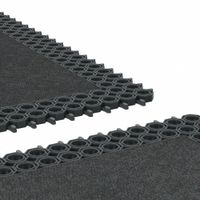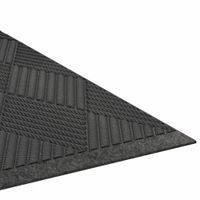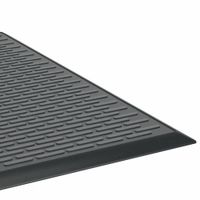Call +(254) 703 030 000 / 751 483 999 / 721 704 777
- Home
- Safety
- Floor Mats
- Entrance Mats
.....Read More
Frequently Asked Questions
What are the benefits of using entrance mats for clean footwear at doorways?
Entrance mats offer several benefits for maintaining clean footwear and enhancing the overall environment at doorways:
1. **Dirt and Moisture Control**: Entrance mats effectively trap dirt, dust, and moisture from shoes, preventing them from being tracked indoors. This reduces cleaning efforts and maintains a cleaner interior environment.
2. **Safety Enhancement**: By absorbing moisture, entrance mats reduce the risk of slips and falls, especially during wet weather conditions. This is crucial for ensuring the safety of both residents and visitors.
3. **Floor Protection**: Mats protect flooring from wear and tear caused by foot traffic, extending the lifespan of interior floors. This is particularly beneficial for high-traffic areas where flooring can quickly become damaged.
4. **Cost Efficiency**: By minimizing the need for frequent cleaning and floor repairs, entrance mats contribute to cost savings in maintenance and replacement expenses.
5. **Aesthetic Appeal**: Available in various designs and colors, entrance mats can enhance the visual appeal of entryways, complementing the interior decor and creating a welcoming atmosphere.
6. **Air Quality Improvement**: By trapping dust and allergens, entrance mats contribute to better indoor air quality, which is beneficial for the health of occupants, particularly those with allergies or respiratory issues.
7. **Branding Opportunities**: Customizable mats can feature logos or messages, providing businesses with an opportunity to reinforce branding and create a professional image right at the entrance.
8. **Durability and Versatility**: Made from robust materials, entrance mats are durable and suitable for various environments, from residential to commercial settings, ensuring long-term use.
In summary, entrance mats are a practical and cost-effective solution for maintaining cleanliness, safety, and aesthetics at doorways, while also offering additional benefits such as floor protection and branding opportunities.
How do scraper mats differ from dryer mats?
Scraper mats and dryer mats serve distinct purposes and are designed differently to meet specific needs.
Scraper mats are primarily used for removing dirt, mud, and debris from footwear. They are typically placed outside or at the entrance of a building. These mats are made from durable materials like rubber, coir, or tough synthetic fibers that can withstand heavy foot traffic and harsh weather conditions. The surface of a scraper mat often features raised patterns or bristles that effectively scrape off dirt and grime from shoes, preventing it from being tracked indoors. Their primary function is to act as the first line of defense against outdoor contaminants.
On the other hand, dryer mats are designed to absorb moisture from shoes, helping to keep indoor floors dry and safe. These mats are usually placed inside the entrance, following a scraper mat. Made from absorbent materials such as microfiber, cotton, or polypropylene, dryer mats are engineered to soak up water, snow, and other liquids. They often have a plush, carpet-like texture that not only absorbs moisture but also provides a comfortable surface to walk on. The backing of dryer mats is typically non-slip to ensure they stay in place and prevent accidents.
In summary, while scraper mats focus on removing solid debris, dryer mats are concerned with absorbing moisture. Both types of mats are essential for maintaining cleanliness and safety in high-traffic areas, but they perform complementary roles in an effective entrance matting system.
What are scraper-dryer mats and how do they work?
Scraper-dryer mats are specialized floor coverings designed to clean and dry footwear as people walk over them, thereby preventing dirt, moisture, and debris from being tracked indoors. These mats are commonly used at entrances of buildings, homes, and businesses to maintain cleanliness and safety.
The construction of scraper-dryer mats typically involves a combination of materials and textures. The top layer often features coarse fibers or ridges made from materials like rubber, polypropylene, or nylon. This layer acts as the "scraper," effectively removing dirt, mud, and other particles from the soles of shoes. The design may include raised patterns or bristles that enhance the scraping action.
Beneath the scraping surface, the mat usually incorporates an absorbent layer. This "dryer" component is often made from materials like microfiber or cotton, which are excellent at soaking up moisture. As individuals walk across the mat, this layer absorbs water from wet shoes, reducing the risk of slips and falls on indoor surfaces.
The base of the mat is typically constructed from non-slip materials such as rubber or vinyl. This ensures the mat stays securely in place, even in high-traffic areas, and provides a stable surface for effective cleaning and drying.
Scraper-dryer mats are available in various sizes, colors, and designs to suit different aesthetic preferences and functional needs. They are easy to maintain, often requiring simple shaking, vacuuming, or washing to remove accumulated dirt and moisture.
Overall, scraper-dryer mats are an effective solution for maintaining cleanliness and safety at entry points, reducing cleaning costs, and prolonging the life of interior flooring by minimizing the ingress of dirt and moisture.
How do interlocking mats provide a custom configuration?
Interlocking mats provide a custom configuration through their modular design, which allows individual pieces to be easily connected and rearranged to fit specific spaces and needs. These mats typically feature a jigsaw puzzle-like edge that enables them to securely lock together without the need for adhesives or tools. This design allows users to create a mat of any size or shape by simply adding or removing pieces, making them highly adaptable to various environments.
The flexibility of interlocking mats is particularly beneficial in spaces with irregular dimensions or unique layouts, such as home gyms, play areas, or trade show booths. Users can start with a basic configuration and expand or modify it as needed, accommodating changes in space requirements or personal preferences. Additionally, the ability to replace individual tiles rather than the entire mat makes maintenance and repairs more convenient and cost-effective.
Interlocking mats are available in a variety of materials, such as foam, rubber, or PVC, and come in different thicknesses, colors, and textures. This variety allows users to customize not only the size and shape of the mat but also its appearance and functionality. For example, softer foam mats might be chosen for a children's play area, while more durable rubber mats could be used in a high-traffic gym setting.
Overall, the interlocking design of these mats offers a versatile and user-friendly solution for creating custom flooring configurations that can be easily adapted to meet changing needs and preferences.
What are the advantages of using disposable mats?
Disposable mats offer several advantages:
1. **Hygiene**: They provide a clean surface for each use, reducing the risk of contamination and the spread of germs, which is particularly beneficial in healthcare settings, restaurants, and gyms.
2. **Convenience**: These mats are easy to use and require no maintenance. After use, they can be simply discarded, saving time and effort in cleaning and upkeep.
3. **Cost-Effective**: While the initial cost may seem higher, disposable mats eliminate the need for cleaning supplies and labor, potentially reducing overall expenses in high-turnover environments.
4. **Portability**: Lightweight and easy to transport, disposable mats are ideal for events, travel, or temporary setups where carrying heavy, reusable mats would be impractical.
5. **Versatility**: Available in various sizes, materials, and designs, they can be tailored to specific needs, such as absorbent mats for spills or non-slip mats for safety.
6. **Environmental Considerations**: Many disposable mats are now made from biodegradable or recyclable materials, minimizing their environmental impact compared to traditional disposable products.
7. **Aesthetic Appeal**: They can be customized with logos, colors, or patterns, enhancing branding or decor in commercial spaces.
8. **Safety**: Designed for single use, they often feature non-slip surfaces, reducing the risk of accidents in wet or high-traffic areas.
9. **Regulatory Compliance**: In certain industries, such as food service, using disposable mats can help meet health and safety regulations by ensuring a consistently clean surface.
10. **Space-Saving**: Without the need for storage of cleaning equipment or reusable mats, they free up valuable space in facilities.
Overall, disposable mats offer practical, hygienic, and flexible solutions for various applications, balancing convenience with functionality.
How do printed message mats enhance safety?
Printed message mats enhance safety by serving as visual communication tools that convey important information and warnings to individuals in a given area. These mats are strategically placed in high-traffic zones, entryways, or areas prone to hazards, ensuring that the message is seen by as many people as possible.
Firstly, they provide clear and immediate communication. By displaying messages such as "Caution: Wet Floor," "Watch Your Step," or "Safety First," they alert individuals to potential dangers, reducing the risk of accidents and injuries. The use of bold colors and large fonts ensures that the messages are easily noticeable, even from a distance.
Secondly, printed message mats contribute to maintaining order and organization. In environments like factories or warehouses, they can indicate safe pathways, restricted areas, or zones requiring protective gear. This helps in guiding foot traffic and ensuring that safety protocols are followed, minimizing the likelihood of accidents.
Additionally, these mats can be customized to include company-specific safety messages or branding, reinforcing a culture of safety within the organization. This not only enhances safety awareness but also promotes a sense of responsibility among employees and visitors.
Moreover, printed message mats often have non-slip surfaces, which provide additional traction and reduce the risk of slips and falls, especially in areas that are frequently wet or oily. This dual functionality of providing both a safety message and a physical safety feature makes them an effective tool in accident prevention.
In summary, printed message mats enhance safety by delivering crucial safety messages, guiding behavior, reinforcing safety culture, and providing physical protection against slips and falls, thereby creating a safer environment for everyone.
What factors should be considered when choosing entrance mats for different areas?
When choosing entrance mats for different areas, consider the following factors:
1. **Location and Traffic**: Determine if the mat will be used indoors or outdoors and assess the foot traffic volume. High-traffic areas require durable mats, while low-traffic areas can use lighter options.
2. **Material**: Choose materials based on location and function. Coir and rubber are ideal for outdoor use due to their durability and weather resistance. Nylon and polypropylene are suitable for indoor use, offering good moisture absorption and dirt trapping.
3. **Size and Shape**: Ensure the mat covers the entire entrance width and extends far enough to allow multiple steps, enhancing dirt and moisture removal. Custom shapes may be needed for unique entryways.
4. **Functionality**: Consider the mat's primary function—scraping dirt, absorbing moisture, or both. Scraper mats are ideal for outdoor use, while absorbent mats work well indoors.
5. **Safety**: Look for mats with non-slip backings to prevent accidents. Beveled edges can reduce tripping hazards, especially in high-traffic areas.
6. **Maintenance**: Choose mats that are easy to clean and maintain. Mats that can be vacuumed, hosed down, or machine-washed are practical for busy areas.
7. **Aesthetics**: Select mats that complement the building's decor and branding. Custom logo mats can enhance brand visibility.
8. **Weather Conditions**: Consider local weather patterns. Mats in rainy or snowy areas should have excellent water absorption and drainage capabilities.
9. **Cost**: Balance quality and budget. Investing in high-quality mats can reduce long-term maintenance costs and enhance safety.
10. **Environmental Impact**: Opt for eco-friendly materials if sustainability is a priority.
By evaluating these factors, you can select entrance mats that effectively meet the needs of different areas, ensuring functionality, safety, and aesthetic appeal.





